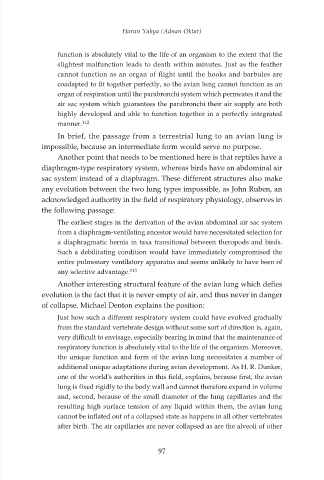Page 99 - Darwinism Refuted
P. 99
Harun Yahya (Adnan Oktar)
function is absolutely vital to the life of an organism to the extent that the
slightest malfunction leads to death within minutes. Just as the feather
cannot function as an organ of flight until the hooks and barbules are
coadapted to fit together perfectly, so the avian lung cannot function as an
organ of respiration until the parabronchi system which permeates it and the
air sac system which guarantees the parabronchi their air supply are both
highly developed and able to function together in a perfectly integrated
manner. 112
In brief, the passage from a terrestrial lung to an avian lung is
impossible, because an intermediate form would serve no purpose.
Another point that needs to be mentioned here is that reptiles have a
diaphragm-type respiratory system, whereas birds have an abdominal air
sac system instead of a diaphragm. These different structures also make
any evolution between the two lung types impossible, as John Ruben, an
acknowledged authority in the field of respiratory physiology, observes in
the following passage:
The earliest stages in the derivation of the avian abdominal air sac system
from a diaphragm-ventilating ancestor would have necessitated selection for
a diaphragmatic hernia in taxa transitional between theropods and birds.
Such a debilitating condition would have immediately compromised the
entire pulmonary ventilatory apparatus and seems unlikely to have been of
any selective advantage. 113
Another interesting structural feature of the avian lung which defies
evolution is the fact that it is never empty of air, and thus never in danger
of collapse. Michael Denton explains the position:
Just how such a different respiratory system could have evolved gradually
from the standard vertebrate design without some sort of direction is, again,
very difficult to envisage, especially bearing in mind that the maintenance of
respiratory function is absolutely vital to the life of the organism. Moreover,
the unique function and form of the avian lung necessitates a number of
additional unique adaptations during avian development. As H. R. Dunker,
one of the world's authorities in this field, explains, because first, the avian
lung is fixed rigidly to the body wall and cannot therefore expand in volume
and, second, because of the small diameter of the lung capillaries and the
resulting high surface tension of any liquid within them, the avian lung
cannot be inflated out of a collapsed state as happens in all other vertebrates
after birth. The air capillaries are never collapsed as are the alveoli of other
97

